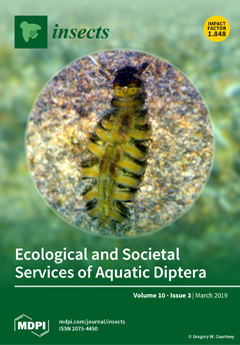The guava fruit fly,
Bactrocera correcta, is one of the major pests affecting mango (
Mangifera indica) and guava (
Psidium guajava) production in China. The compound β-caryophyllene was identified from the rectal gland extracts of wild
B. correcta males
[...] Read more.
The guava fruit fly,
Bactrocera correcta, is one of the major pests affecting mango (
Mangifera indica) and guava (
Psidium guajava) production in China. The compound β-caryophyllene was identified from the rectal gland extracts of wild
B. correcta males and was demonstrated to be a more specific and potent male lure than methyl eugenol (ME) for
B. correcta. In order to find potential additional pheromone attractants for the monitoring and mass-trapping of this fruit fly, a series of chemical and behavioral assays were conducted in this study. Ten compounds were identified from the rectal glands of virgin
B. correcta females. These compounds consisted of five major compounds (i.e., ethyl dodecanoate, ethyl tetradecanoate, ethyl
(E)-9-hexadecenoate, ethyl hexadecanoate, and ethyl
(Z)-9-octadecenoate) in high quantities, and other compounds (i.e., octanal, N-(3-methylbutyl) acetamide, (
Z)-9-tricosene, ethyl octadecanoate, and ethyl eicosanoate) in trace amounts, while virtually no compounds were found in male rectal glands. The bioassays indicate that female rectal gland extracts are attractive to virgin females and males. Furthermore, a cyclical production of the five major compounds was found, recurring at roughly 10-d intervals with peaks in 10–13-, 25-, and 35-d-old females. Collectively, these results will contribute to the understanding of pheromone communication in
B. correcta and may provide important information for improving existing monitoring and control methods for this pest.
Full article






